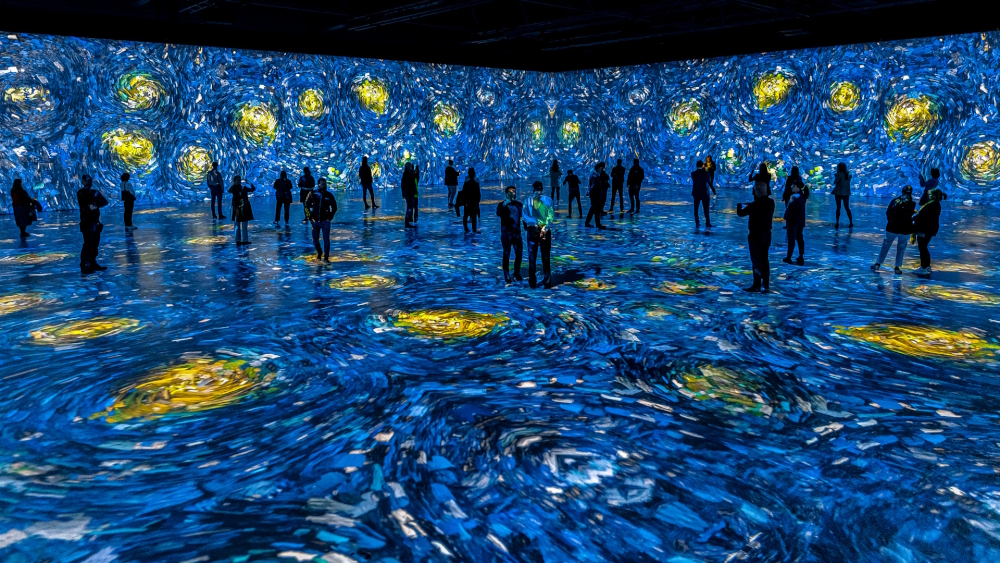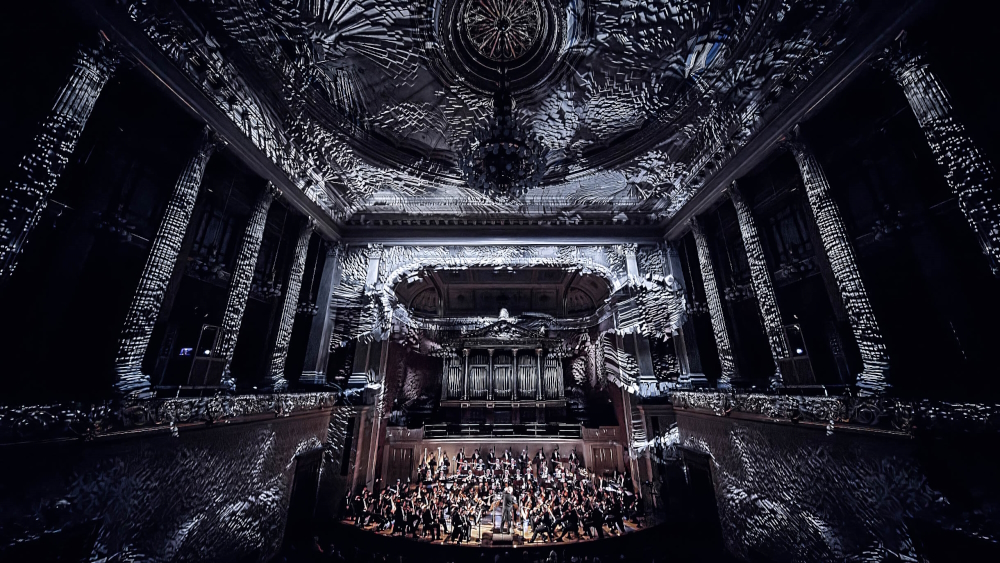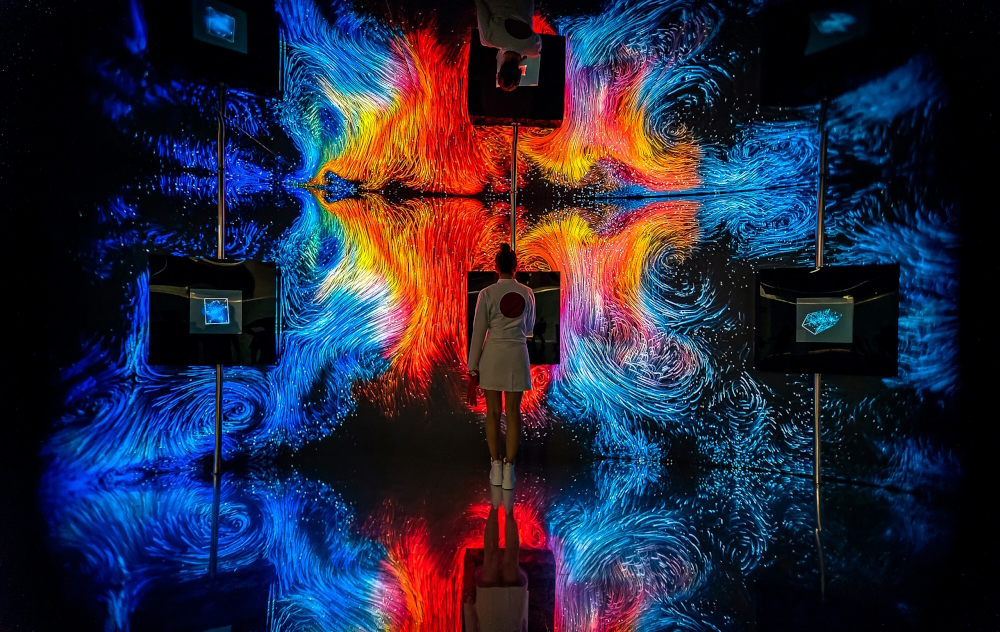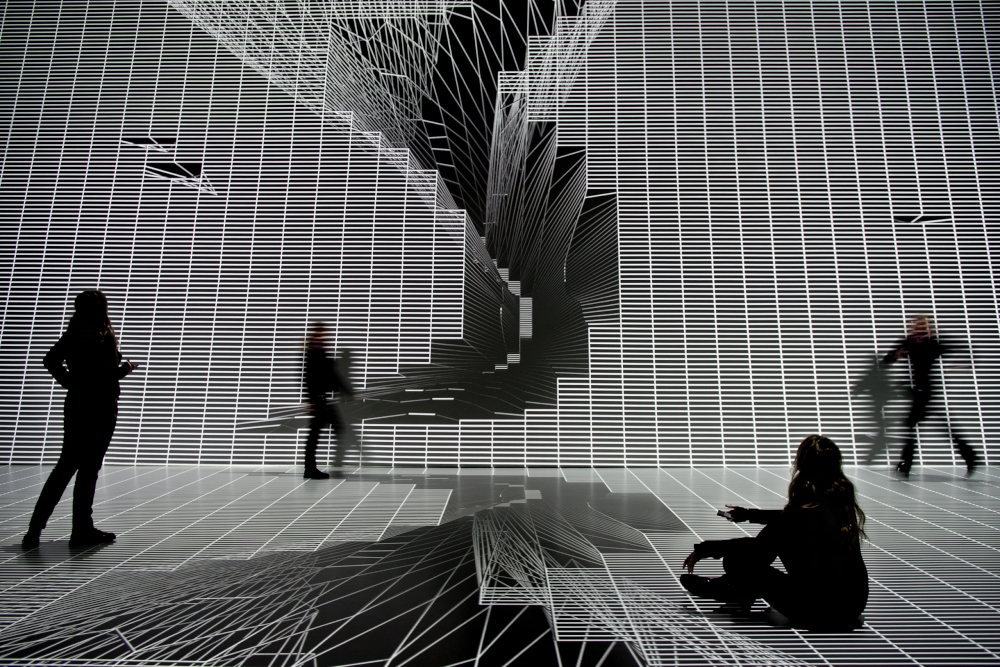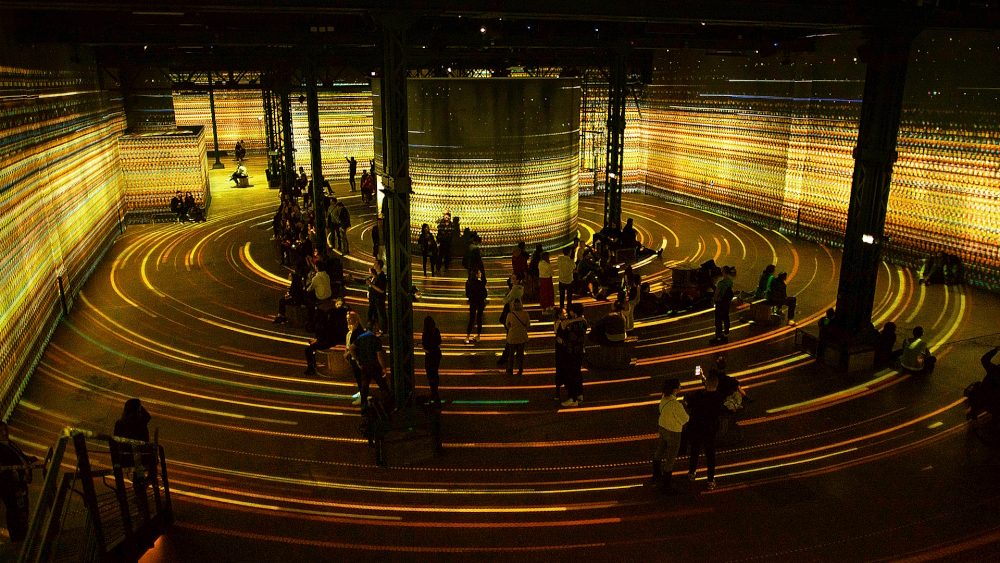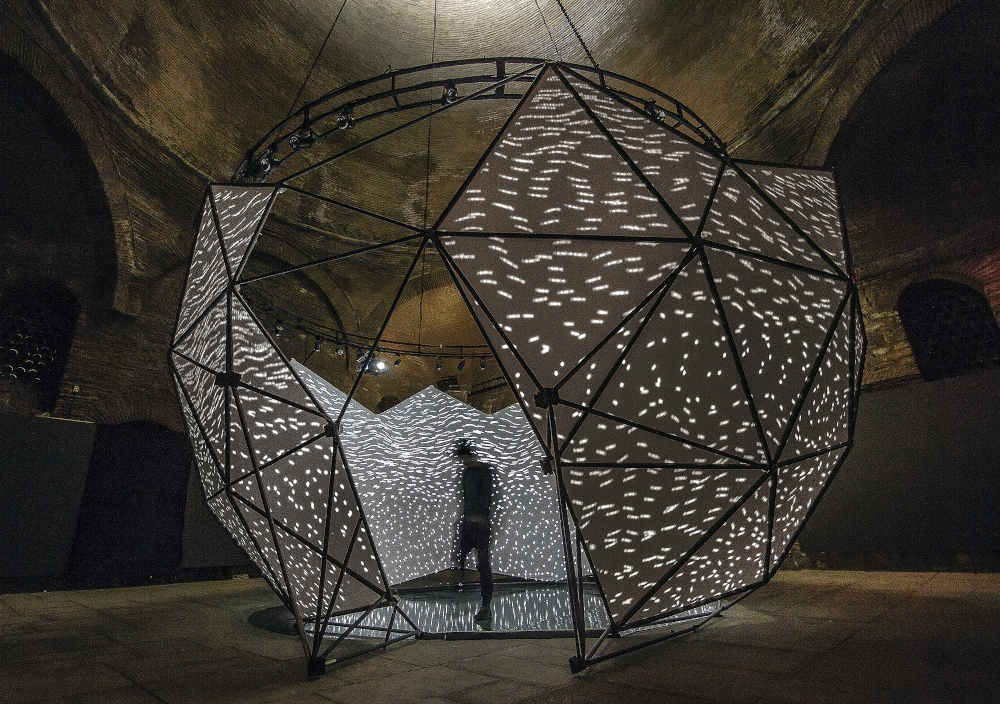Nohlab studio
interdisciplinary experiences around art, design, technology
Turkey
The worldwide presentation of the exhibition „Van Gogh: an immersive journey“. Chanel. Audi. Nike. Siemens. Land Rover. The Pink Floyd exhibition: Their Mortal Remains. Ars Electronica. European Research Council. Greek National Opera. Atelier des Lumieres or EA Theater to name just a few. As diverse as these names are, there’s one connecting link: they and many more are clients of „the leading digital arts and design studio in Turkey“ (artsy.net). This company focuses on producing interdisciplinary experiences „shifting between video art, motion design, projections mapping, kinetic or/and holographic installation, audio-visual design, art direction“ (digicult.it). „It builds a bridge between the digital and the physical reality, while examining the relationship of technology with art and design“, is to be read on the practice website. „The production of tools, designs and stories in which the connection between the human and technology reflects in many different ways.“ While all that has to be structured perfectly always, the founding of the studio was not planned at all...
Nohlab studio
interdisciplinary experiences around art, design, technology
Turkey
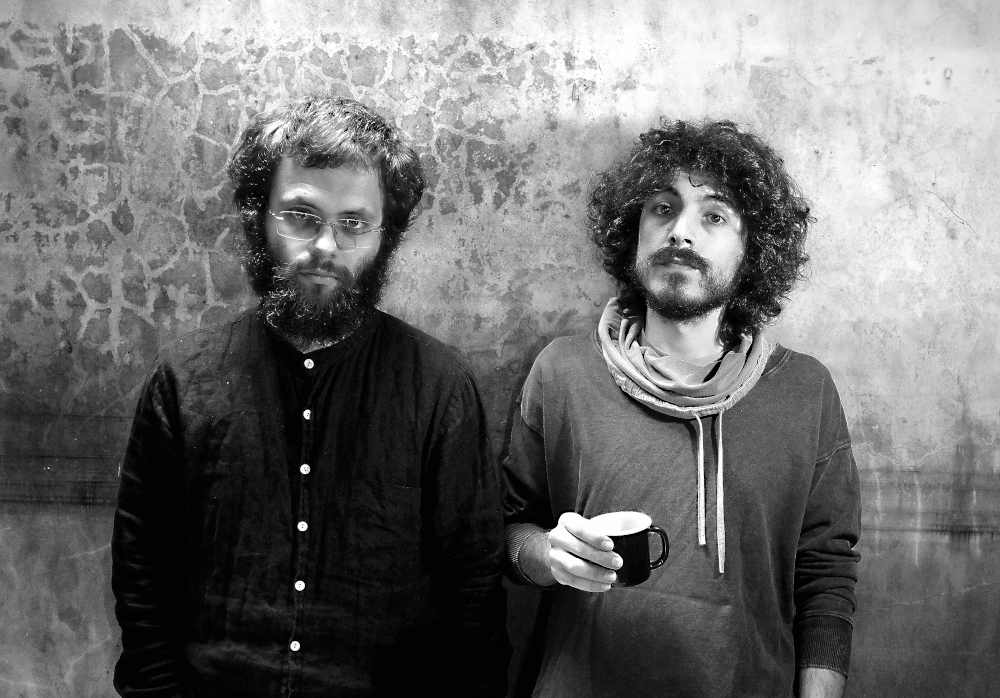
„We experimented with things we wanted to try and do - maybe we can call it the zeitgeist“, the directors of Nohlab told clotmag.com. „As we experimented, we realised it is also where the world goes and will go.“ In 2011 they founded their company. The basis for doing so was strong already. Candaş Şişman and Deniz Kader were long-time friends, who visited Anatolian Fine Art High School in Izmir from 1999 up until 2003. Then they studied Animation and Motion Design at Anadolu Üniversitesi in Eskişehir and graduated in 2008. Two years later the two started their professional creative collaboration by „designing inclusive and participatory environments through audio-visual works and performances“ (digicult.it), „where the connection between man and technology can be expressed in different ways“ (tffmagazine.com). These are either custom-made projects for museums, festivals, buildings and events or commercial jobs. Furthermore their studio realizes own themed exhibitions in big cities like New York, Paris, Dublin or Istanbul.
The approach of Nohlab’s leaders regarding their general design process is an unusual one. They described it while talking to clotmag.com: „We turn the concepts we want to convey into stories rather than conceptualising the stories. In other words, the starting point is usually not the story itself but our conceptual and sensual thoughts on a more abstract level. We turn these into an immersive experience using various elements of experience design and using contemporary storytelling methods. Turning the concepts dwelling in our minds into stories, concepts especially like existence, physics, future, nature, and reality, we try to associate with various aesthetic approaches and methods we have at hand, protecting our artistic language.“
„For us, doing is creating“, is their quote on digicult.it. „In time, creating turns into passion harbouring ambition. It’s a form of expression, a way of existence. To share and to create is the basis of what we do. It’s an ongoing process that comes out of nothing. All that you see and live, through your whole memory is the main part of this process.“
The owners of Nohlab as well as their practice are based in Turkey.
Interview July 2024
Building bridges between digital and physical: a balance between art and commerce
INTUITION/IMAGINATION
?: How does intuition present itself to you – in form of a suspicious impression, a spontaneous visualisation or whatever - maybe in dreams?
We usually experience intuition as spontaneous visualizations, or sudden insights. These moments can arise during everyday life or while working on other projects, feeling both familiar and new at the same time. This kind of intuition often serves as the starting point for our projects, propelling us towards new discoveries
?: Will any ideas be written down immediately and archived?
Yes, we do care to note down ideas. It can be a concept, a technology or an implementation of the immersive experience method. Recording our ideas is an important part of our creative process. It allows us to capture the essence of inspiration and revisit and develop these ideas when appropriate. For example, in developing our sound responsive, real-time visual project "NOS Visuals", we had taken notes of so many ideas to ensure the synchronization of sound and visuals and to experiment with form and motion control combinations, before we actually achieved the result.
?: How do you come up with good or extraordinary ideas?
These kinds of ideas emerge from a blend of curiosity, observation, and life experiences. We draw inspiration from a wide range of sources from nature to technology, and allow our own experiences to fuel our imagination. Collaborating with other creative minds also helps generate new ideas which are above the line. By feeding from various disciplines and constantly exploring new things, we can develop these ideas even further.
?: Do you feel that new creative ideas come as a whole or do you get like a little seed of inspiration that evolves into something else and has to be realized by endless trials and errors in form of constant developments until the final result?
We find that they rather start as a small seed of inspiration in our case. This seed evolves through trials, errors, and continuous development. The final result is a product of this iterative process, where the initial idea is refined and expanded. This process involves constant transformation until the final outcome is achieved.
?: What if there is a deadline, but no intuition? Does the first fuel the latter maybe?
Yes. The pressure of a deadline forces us to think creatively faster, focus and come up with solutions or alternative ideas that we might not normally consider. In our experience, this can be a catalyst for intuition and innovation. Working under time pressure can accelerate our creative process and help us come up with new, results-oriented ideas. Deadlines can really trigger intuition and creativity for us.
INSPIRATION
?: What inspires you and how do you stimulate this special form of imaginativeness?
We draw inspiration from a broad spectrum. This includes nature, science, technology, and art. To foster our imagination, we explore different disciplines, collaborate with other artists and participate in exhibitions, exposing ourselves to new experiences and perspectives. By continuously observing and experiencing these sources of inspiration, we nourish our imagination. For example, in our project Journey, we created a new experience inspired by the sciences of physics and biology. The layers of the eye and envisioning the journey of a photon particle stimulated both the visual imagery and the immersive experience design.
?: How do you filter between ideas that are worthwhile pursuing and bad ones that you just let go of?
We filter ideas through a combination of intuition, feasibility, and potential impact. We pursue ideas that align with our vision and have the potential to create meaningful experiences, while carefully discarding those that do not meet these criteria. When evaluating ideas, we focus on their experiential and aesthetic values. We assess whether they align with the overall concept and stance of our projects.
?: Does an idea need to appeal to you primarily or is its commercial potential an essential factor?
It should appeal to us first. Although commercial potential is undoubtedly important, we believe that creative and artistic value is always the priority. Working on ideas and concepts that match our interests and passions allows us to achieve the best results in line with our potential. By creating a balance between art and commerce, we try to produce projects that are both creative and financially sustainable. In this regard, we have collaborated for commissions with many institutions, organizations, and global brands such as Chanel, Nike, Land Rover, Siemens, and many more.
?: Do you revisit old ideas or check what colleagues or competitors are up to at times?
We revisit old ideas indeed, to see if we can improve them with new insights or technologies. This feeds our creative process and helps us gain new perspectives. Sometimes the specific technology that would best reflect the idea isn’t practical yet, at the time the idea was conceived. It is useful to evaluate many ideas that have encountered obstacles in terms of technology, with rapidly developing means. And of course, we also keep an eye on what our colleagues and competitors are doing; which both keeps us up to date, and informs, inspires and motivates us in many ways.
CREATIVITY
?: What time or environment best suits your creative work process — for example, a time and place of tranquility or of pressure? Which path do you take from theory or idea to creation?
Both peace and pressure can play significant roles in our creative process. Peace allows for deep thinking and exploration, while pressure encourages quick and innovative thinking. We usually start our projects with a concept or idea, then move through stages of experimentation, prototyping, and refinement. So the most suitable time and environment for our creative process is generally a quiet, calm, and focused setting. However, sometimes working under pressure can really accelerate both our focus, and our creative process, leading us to discover faster and more practical methods.
?: What’s better in the realization process — for example, speed and forcing creativity by grasping the magic of the moment or a slow, ripening process for implementation and elaboration?
Again here as well, both approaches have their own advantages and own unique experiences. While speed and improvisation can capture the magic of the moment, the slow maturation process provides the opportunity for deep exploration and refinement. We use both methods depending on the dynamics of the project. While speed and compelling creativity can be effective in capturing the magic of the moment with surprising results, the slow maturation process can also produce deeper and more meaningful results. In artistic projects for example, we usually spend a lot of time during the process, which helps to make the end result more qualified. In the process of rapid results, on the other hand, we challenge ourselves and push our limits.
?: How important are self-doubt and criticism by others during such a process?
Self-doubt and external criticism are crucial for growth and development. They help us question our assumptions, refine our ideas, and avoid complacency. Constructive criticism from respected individuals is particularly valuable, as it offers new perspectives. We are usually not satisfied with our work and are exceptionally self-critical. Although this self-doubt can cause challenging periods during production, it keeps us in a constant search, contributing to our creative evolution.
?: Is it better to be creative on your own, to trust only your own instincts, or to work in a team?
Both individual creativity and teamwork are important. Each has its own value and results in different outcomes. Trusting our instincts preserves the originality and subjectivity of our projects, while working within a team enriches our projects with diverse perspectives and skills. We cannot deny that collaborating in a team brings different viewpoints and abilities, resulting in richly produced projects with strong objectivity. Both of them speak to us, and we need both creatively.
?: In case of a creative block or, worse, a real failure, how do you get out of such a hole?
We think of creative blocks and failures as opportunities to learn and grow. Taking breaks, seeking inspiration from outside sources, and discussing challenges with team members/fellow designers can help overcome these obstacles. It is not surprising that, in the event of a creative block or failure in digital design, the most effective results can come from returning to nature. Or you should let go of the confinement of your discipline and draw from different disciplines. Both help in seeking new sources of inspiration, and reevaluating our projects in a new light.
?: Should a creative person always stay true to him- or herself, including taking risks and going against the flow, or must the person, for reasons of commercial survival, make concessions to the demands of the market, the wishes of clients and the audience’s expectations?
Balancing personal integrity with commercial demands is difficult but necessary. Staying self-reliant to yourself and taking risks can lead to groundbreaking results, but it is also important to consider market and audience demands for feasibility. It may also be a necessity to adapt to market demands and customer expectations for commercial survival. But nothing stops you from staying true to yourself. You may always push to elongate the boundaries of the demands you receive. You may start with a wildly chewn path as per demands, but you may also always try to design your unique way into the process. This would usually also help with the quality of results you’ll get from the process. You may also push them to see things in different angles, expand their expectations from the experience and shape new possibilities. Finding this balance allows us to produce projects that are both creative and feasible.
?: How are innovation and improvement possible if you’ve established a distinctive style? Is it good to be ahead of your time, even if you hazard not being understood?
Well, innovation and development are possible, if one continually challenges oneself and discovers new techniques and ideas. Establishing a unique style is more acceptable, if it comes from a sincere and long process. Many creatives shape their style based on demand or as a sales strategy, which we believe should be questioned. Style can limit creativity, as reaching a conclusion slows down the quest. We prefer to call it "creative language" instead of style, because being in constant change and transformation can better connect with the reality we live in. The most important requirement for development after establishing a creative language is continuous searching and questioning based on this foundation. Declaring "this is who I am" narrows down many potential possibilities.
Being ahead of your time can be risky in the short term, but it often leads to pioneering work. While it may carry the risk of being misunderstood at times, it can yield valuable results in the long term.
?: When does the time come to end the creative process, to be content and set the final result free? Or is it always a work-in-progress, with an endless possibility of improvement?
Knowing when to end a creative process is an art form. There is always room for improvement, and yes, you can always make a work better if you work on it forever. Sometimes the result is never as it was in your head, not even close. But this loop never ends, you have to accept there comes a point when work needs to be released. We of course try to rely on our intuition when doing that, but as artists it will always be our wish to see our work presented in better forms. Sometimes what brings us to the ending point is the feedback from the outside; our team, our clients, the timelines, the deadlines… Every project, while still having the potential for continued improvement, should be considered complete at some point, and it will usually be hard to accept it for sure.
?: How does artificial intelligence change human creativity? And do you? Would will you use it at all?
AI transforms human creativity by accelerating it and offering new perspectives. AI's rapid iteration capability speeds up the idea development process and allows for more possibilities to be explored. Additionally, AI's analysis and synthesis capabilities show artists paths and combinations they hadn't considered before, expanding creativity. For instance, thanks to AI technologies, artists can create works of unprecedented complexity and detail. AI algorithms analyze large datasets and suggest new ideas, forms, and solutions that inspire artists.
Moreover, AI automates routine and repetitive tasks, providing artists with more creative freedom. This allows artists to devote more time to creative processes and developing innovative ideas. Collaborating with AI offers artists different perspectives, pushing their boundaries and allowing them to discover new forms of expression.
We are open to using AI and have been using it for a long time. What matters is that it aligns with our artistic vision and project concept, not using it just because it's a "hype" or for sales concerns. For example, in our Van Gogh - An Immersive Journey project, we used AI technologies to analyze the artist's style and combined it with our approach to create a new experience. We are always excited to integrate such innovative technologies into our projects and believe we will use AI more frequently in different areas as a "collaborative partner" in the future.
SUCCESS
?: Should or can you resist the temptation to recycle a ‘formula’ you're successful with?
Reusing a successful formula can be tempting, but creativity requires constantly pushing boundaries and discovering new ideas. Stagnation is the enemy of creativity. We strive to maintain balance in this regard. We don't hesitate to use some formulas when necessary and at appropriate times, but we are also cautious against the risk of constant repetition and producing endless variations. Formulas can save time but narrow possibilities. We strive to balance this intuitively and logically.
?: Is it desirable to create an ultimate or timeless work? Doesn’t “top of the ladder” bring up the question, “What’s next?” — that is, isn’t such a personal peak “the end”?
Creating a timeless work is a noble and essential aim we may say. It is there as an aim. However, the journey of creativity is continuous. Reaching a pinnacle should not stop but inspire us to set new challenges and continue our evolution. Creating an "ultimate or timeless work” is desirable, but it does not necessarily mean the end of the creative process. Creativity is not one mountain to conquer, but it can be a range of mountains. There are always new peaks and new fields to explore. The creative process is a continuous journey.
MY FAVORITE WORK:
We believe that these three creations represent us best: Everything, Flow and Journey. Each one showcases how Nohlab combines art, design, and technology to offer profound, thought-provoking experiences to the audience.
Everything stands out with its conceptual depth. In this work, we bring together science, philosophy, and metaphysics while questioning the fundamental elements of existence. We invite the audience on a visual and auditory journey, exploring the meaning of life and the complexity of the universe. Everything is a thought experiment that allows the audience to question their own existence and perceptions. This project aims to go beyond the world perceived through our limited senses and face the unknown. Everything reminds us of the vastness of the universe and the many layers waiting to be discovered, emphasizing the importance of existing within constantly evolving possibilities.
Flow Exhibition, in its entirety, stands out by offering an experiential spatial experience that combines physical and digital elements. In this experience, we bring together light, sound, movement, and space, presenting the audience with a three-part journey. Flow reshapes the audience's perception of space and time by blending physical and digital elements.
Journey stands out with its experiential storytelling. In this work, we narrate the journey of photons, the fundamental particles of light, from their interaction with the eye to being perceived by the brain. The audience experiences everything as the light particles on a journey, moving through the different layers of the eye we have spatialized and getting lost in a visual-auditory story flow.

